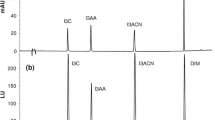Abstract
The incubation of 13-hydroperoxy-9Z,11E,15Z-octadecatrienoic acid (13-HPOT) with a hydroperoxide lyase containing extract of mung bean seedlings (Phaseolus radiatus L.) led not only to the formation of 2E-hexenal, but also to the generation of several non-volatile by-products (oxylipins). These oxylipins, generated by the catalysis of other 13-HPOT metabolizing enzymes, were analyzed by high performance liquid chromatography (HPLC) without time-comsuming derivatization procedures, which would be necessary for their volatilization and stabilization during gaschromatography (GC). Different detection systems such as an evaporative light-scattering detector (ELSD), diode-array detector (DAD), and particle beam-mass spectrometry (PB-MS) were applied. The utilization of an ELSD represented an improvement of sensitivity compared to a DAD, especially in the case of substances with low UV-activity.
Similar content being viewed by others
Author information
Authors and Affiliations
Additional information
Received: 23 July 1997 / Accepted: 3 November 1997
Rights and permissions
About this article
Cite this article
Rehbock, B., Ganßer, D. & Berger, R. Different detection systems for the HPLC analysis of oxylipins, by-products of the enzymatic generation of 2E-hexenal. Fresenius J Anal Chem 360, 830–832 (1998). https://doi.org/10.1007/s002160050820
Issue Date:
DOI: https://doi.org/10.1007/s002160050820




